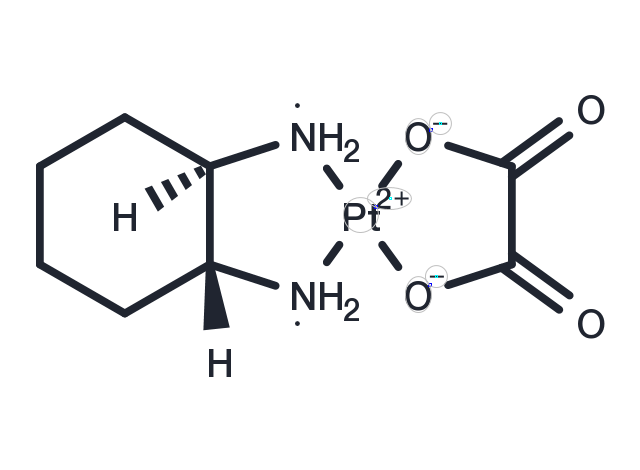keep away from direct sunlight | Powder: -20°C for 3 years | In solvent: -80°C for 1 year
Oxaliplatin (L-OHP) 是一种 DNA 烷化剂,一种 DNA 合成抑制剂。Oxaliplatin 会导致 DNA 交联损伤,阻止 DNA 复制和转录并导致细胞死亡。Oxaliplatin 可以诱导细胞自噬。

| 规格 | 价格/CNY | 货期 | 数量 | |
|---|---|---|---|---|
| 25 mg | ¥ 268 | 现货 | ||
| 50 mg | ¥ 460 | 现货 | ||
| 100 mg | ¥ 686 | 现货 | ||
| 200 mg | ¥ 1,178 | 现货 | ||
| 500 mg | ¥ 1,750 | 现货 | ||
| 产品描述 | Oxaliplatin (L-OHP) is a DNA alkylating agent, an inhibitor of DNA synthesis. Oxaliplatin causes DNA cross-linking damage, preventing DNA replication and transcription and leading to cell death. Oxaliplatin induces autophagy. |
| 体外活性 |
方法:人结肠癌细胞 HT29、SW620、WiDr 和 LS174T 用 Oxaliplatin (0.001 ng/ml-100 µg/mL) 处理 24 h,使用 MTT 方法检测细胞毒性。 结果:Oxaliplatin 对 HT29、SW620、WiDr 和 LS174T 细胞具有细胞毒性,IC50 分别为 0.33、1.13、0.13 和 0.19 μg/mL。[1] 方法:人结肠癌细胞 HCT116 WT 和 CHK2 KO 用 Oxaliplatin (40 µM) 处理 24-96 h,使用 Flow Cytometry 方法检测细胞凋亡情况。 结果:Oxaliplatin 处理 24-96 h,WT 和 CHK2-KO 细胞系中的凋亡水平增加。处理 24-72 h,WT 细胞的凋亡水平始终比 CHK2 KO 细胞低两倍。然而,处理 96 h,WT 和 CHK2-KO 细胞的凋亡水平相同 (85%)。[2] 方法:人口腔鳞状细胞癌细胞 CAL27 用 Oxaliplatin (31.25-125 μM)、SCC25 用 Oxaliplatin (25-100 μM) 处理 12-36 h,使用 Wound-healing 方法检测细胞迁移情况。 结果:Oxaliplatin 以剂量依赖的方式对 CAL27 和 SCC25 细胞的迁移具有抑制作用。[3] |
| 体内活性 |
方法:为检测体内抗肿瘤活性,将 Oxaliplatin (5 mg/kg) 和 piperlongumine (2.5 mg/kg) 腹腔注射给携带人结直肠癌肿瘤 HCT-116 的 BALB/c nu/nu 小鼠,每天一次,持续二十四天。 结果:Oxaliplatin 和 piperlongumine 联合治理显著抑制肿瘤生长。Piperlongumine 可以通过 ROS 介导的细胞凋亡在体内使肿瘤对 Oxaliplatin 敏感。[4] 方法:为建立铂类药物诱导的疼痛性周围神经病变模型,将 Oxaliplatin (3 mg/kg/天) 腹腔注射给 C57BL6J 小鼠,注射五天,休息五天,持续两个周期。 结果:Oxaliplatin 治疗组的小鼠表现出显著的机械性异常性疼痛。Oxaliplatin 组在后足表现出明显的冷痛觉过敏。[5] |
| 激酶实验 | Binding experiments of electrophysiology: CHO cells expressing the subunit of the voltage-dependent L-type Ca2+ channel are cultrured in medium without serum in the presence of different concentrations of Nisoldipine. Then Ca2+ channel current elicited from a holding potential of -100 mV or -50 mV is recorded at room temperature with the whole-cell configuration of the patch-clamp method using the List EPC-7 patch-clamp amplifer and pClamp software. The concentration of competitor inhibiting 50% of the specific binding represents IC50. |
| 细胞实验 | The cytotoxicity studies are carried out with the sulforhodamine-B microculture colorimetrie assay. Typically, cells are plated into 96-well plates on day 0 and exposed to Oxaliplatin on day 1; the sulforhodamine-B assay is carried out 48 h after Oxaliplatin exposure. The plates are incubated at 37 °C in 5% CO2 and 100% relative humidity at all times except when adding Oxaliplatin and during the final assay period. The initial number of cells plated for the assay ranged from 2-20 × 103 cells/50 /nL/well. The numbers of cells for plating and the drug exposure time are based on pilot studies using the criteria that (a) the cells in control wells are still in the log phase of growth on the day of the assay; (b) the maximum absorbance for the untreated controls on the day of the assay is in the range of 1.0 to 1.5; and (c) cells go through >2 doublings during the drug exposure. Eight wells are used per concentration. The plates are read at 570 and/or 540 nm using a Biotek Instruments model EL309 microplate reader interfaced with an IBM PC-compatible computer. The data are transferred and transformed into a LOTUS 1-2-3 format by the computer program DATALOG, and survival fractions are calculated by comparing the drug treated with control(Only for Reference) |
| 别名 | L-OHP, 奥沙利铂 |
| 化合物与蛋白结合的复合物 |
NMR Solution Structure of an Oxaliplatin 1,2-d(GG) Intrastrand Cross-Link in a DNA Dodecamer Duplex |
| 分子量 | 397.29 |
| 分子式 | C8H14N2O4Pt |
| CAS No. | 61825-94-3 |
keep away from direct sunlight | Powder: -20°C for 3 years | In solvent: -80°C for 1 year
Ethanol: < 1 mg/mL (insoluble)
DMSO: 50 mg/mL (125.85 mM), DMSO inactivates the activity of Oxaliplatin.
H2O: 3 mg/mL (7.55 mM), Sonification and heating to 60℃ are recommended.
DMF: 1.67 mg/mL (4.20 mM), Sonification is recommended.
| 可选溶剂 | 浓度 体积 质量 | 1 mg | 5 mg | 10 mg | 25 mg |
| DMSO / H2O / DMF | 1 mM | 2.5171 mL | 12.5853 mL | 25.1705 mL | 62.9263 mL |
| DMSO / H2O | 5 mM | 0.5034 mL | 2.5171 mL | 5.0341 mL | 12.5853 mL |
| DMSO | 10 mM | 0.2517 mL | 1.2585 mL | 2.5171 mL | 6.2926 mL |
| 20 mM | 0.1259 mL | 0.6293 mL | 1.2585 mL | 3.1463 mL | |
| 50 mM | 0.0503 mL | 0.2517 mL | 0.5034 mL | 1.2585 mL | |
| 100 mM | 0.0252 mL | 0.1259 mL | 0.2517 mL | 0.6293 mL |
对于不同动物的给药剂量换算,您也可以参考 更多...
请在以下方框中输入您的动物实验信息后点击计算,可以得到母液配置方法和体内配方的制备方法: 比如您的给药剂量是10 mg/kg,每只动物体重20 g,给药体积100 μL,一共给药动物10 只,您使用的配方为5% DMSO+30% PEG300+5% Tween 80+60% ddH2O。那么您的工作液浓度为2 mg/mL。
母液配置方法:2 mg 药物溶于 50 μL DMSO (母液浓度为 40 mg/mL), 如您需要配置的浓度超过该产品的溶解度,请先与我们联系。
体内配方的制备方法:取 50 μL DMSO 主液,加入 300 μL PEG300, 混匀澄清,再加 50 μL Tween 80,混匀澄清,再加 600 μL ddH2O, 混匀澄清。
您可能有的问题的答案可以在抑制剂处理说明中找到,包括如何准备库存溶液,如何存储产品,以及基于细胞的分析和动物实验需要特别注意的问题。
Oxaliplatin 61825-94-3 Autophagy Cell Cycle/Checkpoint DNA Damage/DNA Repair DNA Alkylator/Crosslinker DNA/RNA Synthesis L-OHP DNA cross-links anticancer 奥沙利铂 Inhibitor apoptosis inhibit inhibitor
